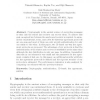255 search results - page 13 / 51 » Principles for Entity Authentication |
ASIACRYPT
2003
Springer
14 years 19 days ago
2003
Springer
Authenticated Key Establishment (AKE) protocols enable two entities, say a client (or a user) and a server, to share common session keys in an authentic way. In this paper, we revi...
TDSC
2008
13 years 7 months ago
2008
Inspired by unidirectional error detecting codes that are used in situations where only one kind of bit error is possible (e.g., it is possible to change a bit "0" into a...
IFIPTM
2010
13 years 5 months ago
2010
Abstract. Location-dependent services are services that adapt their behavior based on the locations of mobile devices. For many applications, it is critical that location-dependent...
ACSAC
2008
IEEE
14 years 1 months ago
2008
IEEE
pwdArmor is a framework for fortifying conventional password-based authentications. Many password protocols are performed within an encrypted tunnel (e.g., TLS) to prevent the exp...
MDAI
2005
Springer
14 years 27 days ago
2005
Springer
Cryptography is the ancient science of encrypting messages so that only the sender and receiver can recover them. To achieve this goal, an agreed key between the sender and receive...

